
Timescale
Timescale
| Palaeos: |  |
Geological Timescale |
| Time | Geological Timescale |
Although (as explained in the parent unit (more inclusive unit) of this topic) there are many possible timescales (which range from the very long (billions of years) to the very short) , Geological time, which deals in millions or tens of millions of years, is the main focus here at Palaeos. Therefore this page provides the starting point for an overview of Earth history. In exploring geological time, we explore the history and evolution of life in all its incredible diversity, the drift of continents, the rising and erosion of mountains, and long term climatic cycles of greenhouses and ice ages.
Scientists divide the Earth into a number of periods - the "Geological time-scale", according to the rock types and sort of fossils found in each one. These divisions are pretty arbitrary, like all such man-made classifications, but they at least can serve as useful labels, so we can orientate ourselves in our journeys through deep time. So the Paleozoic, the era of "ancient life" is characterized by fossils of invertebrates, primitive tetrapods, etc; the Mesozoic or era of "middle life", by fossils of dinosaurs etc, and the Cenozoic or era of "recent life" by mammals and modern plants and invertebrates. These eras are divided into periods, the system of which was established by the middle of the last century. The periods are in turn divided into epochs, and the epochs are divided into ages called ages. (more on these subdivisions) We know these intervals lasted for millions of years, or even tens or hundreds of millions, because they can be dated them with a fair degree of accuracy according to the amount of radioactivity that occurs in the rocks. We even have a rough idea of geological timescales on the moon and Mars.
The colours associated with each have no other significance, other than to brightly label jars of geological specimens, and brighten up the Palaeos timeline pages. By convention, the oldest units are at the bottom, the youngest at the top (representing the order of deposition of strata, as this diagram derives originally from 19th century geology) . To see our still very incomplete overview of the history of life on Earth, click on one of the following links or images. Or select a stage from the detailed colour-coded chart of the geological timescale.
| Eon | Era | Period | begin - end (Mya) | |
|---|---|---|---|---|
| Phanerozoic Eon: PH | Cenozoic Era: CZ | Neogene N | 23.0 - | |
| Paleogene E | 65.5 - 23.0 | |||
| Mesozoic Era: MZ | Cretaceous K | 146 - 65.5 | ||
| Jurassic J | 200 - 146 | |||
| Triassic T | 251 - 200 | |||
| Paleozoic Era: PZ | Permian P | 299 - 251 | ||
| Carboniferous C | 359 - 299 | |||
| Devonian D | 416 - 359 | |||
| Silurian S | 444 - 416 | |||
| Ordovician O | 488 - 444 | |||
| Cambrian Є | 542 - 488 | |||
| Precambrian*: Prc | Proterozoic PR | 2500 - 542 | ||
| Archean AR | 3850 - 2500 | |||
| Hadean* HA | c. 4500 - 3850 | |||
| Chaotian* CH | c. 4600-4500 | |||
For the sake of brevity the eras and periods of the three Precambrian eons are not shown here. Asterisks show time units that are not officially recognised.
The geological time-scale is here used to define the major stages in the history of life on Earth. Here the four and a half billion year history of planet Earth is divided into six segments, although this is semi-informal classification, mixing eons and eras. A brief overview of each is shown below.
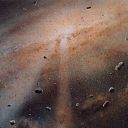
Chaotian Eon
This era begins with the formation of the Solar System and the Earth from planetesimals in the solar nebula. Mineral evolution begins at this time (although presumably it has already occurred many times in other, early, solar systems.
|
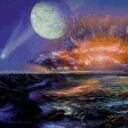
Hadean Eon
The name says it all; a hellish period lasting some 760 million years, when the Earth was subject to frequent bombardment by comets, asteroids, and other planetary debris. This era begins when a Mars-sized body struck the original Earth, pulverizing both, and reforming into the current Earth-moon binary. Gradually the molten Earth cools, outgassing of first atmosphere and oceans, bombardment by left-over planetesimal and debris. The Hadean eon was characterized by extensive volcanism and formation of the first crust. Following a second period of cosmic bombardment, by the end of the Hadean, the Earth had an atmosphere (unbreathable to most organisms today), and oceans filled with water.
|
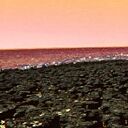
Archean Eon
Lasting more than twice as long as the Phanerozoic eon, the Archean was a time when diverse microbial life flourished in the primordial oceans, and the continental shields developed from volcanic activity. The reducing (anaerobic) atmosphere enabled Archaea (anaerobic microbes) to develop, and plate tectonics followed a regime of continental drift different to that of the Proterozoic and later. During this era, one type of organism, the Cyanobacteria (blue-green algae) produced oxygen as a metabolic by-product; the eventual build-up of this highly reactive gas was to eventually prove fatal to many life-forms, and converted the atmosphere from.
|
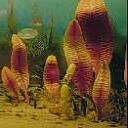
Proterozoic Eon
The Proterozoic, which lasted even longer than the Archean Era, saw the atmosphere changes from reducing to oxygenated, driving the original anaerobic inhabitants of the Earth into a few restricted anoxic refuges and enabling the rise of aerobic life (both prokaryote and the more complex eukaryotic cell, which requires the high octane boost that oxygen enables.) Stromatolites (colonial cyanobacteria), which had appeared during the Archean, were common. The modern regime of continental drift began, and saw the formation of supercontinent of Rodinia, and several extensive ice ages. Late in the Proterozoic a runaway icehouse effect meant that the
preceding warm conditions were replaced by a "Snowball Earth" with ice several kilometers deep covering the globe. Warming conditions saw the short-lived Ediacarian biota and finally the appearance of first metazoa.
|
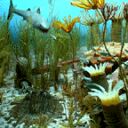
Paleozoic Era
Early in the 300 million year history of the Paleozoic, atmospheric oxygen reached its present levels, generating the ozone shield that screens out ultraviolet radiation and allows complex life to live in the shallows and finally on land. This era witnessed the age of invertebrates, of fish, of tetrapods, and (during the
Permian) reptiles. From the Silurian on, life emerged from the sea to
colonize the land, and in the later Paleozoic pteridophyte and later gymnospermous plants flourished. The generally mild to tropical conditions with their warm shallow seas were interspersed with Ordovician and Permo-Carboniferous ice ages. Towards the end of the Paleozoic the continents clustered into the supercontinent of Pangea, and increasingly aridity meant the end of the great Carboniferous swamps and their unique flora and fauna. The Paleozoic was
brought to an end by the end Permian mass-extinction, perhaps the most severe extinction the planet has seen.
|

Mesozoic Era
Lasting little more than half the duration of the Paleozoic, this was a spectacular time. The generalized archosaurian reptiles of the
Triassic gave way to the dinosaurs, a terrestrial megafauna the like of which the Earth has not seen before or since. While dinosaurs dominated the land, diverse sea-reptiles ruled the oceans, and invertebrates, especially ammonites, were extremely diverse. Pterosaurs and later birds took to the sky. Mammals however remained small and insignificant. Climatic conditions remained warm and tropical worldwide. The supercontinent of Pangea broke up into Laurasia and Gondwana, with different dinosaurian faunas evolving on each. During this era modern forms of corals, insects, new fishes and finally flowering plants evolved. At the end of the Cretaceous period the dinosaurs and many other animals abruptly died out, quite likely the result of an asteroid impact and associated extensive volcanism (acid rain)
|
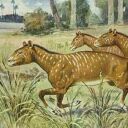
Cenozoic Era
With the extinction of the dinosaurs and the end of the Mesozoic, the mammals swiftly inherit the Earth. Archaic mammals co-existed with
birds and modern reptiles and invertebrates. The current continents emerged, and the initial tropical conditions were replaced by a colder drier climate, possibly caused by the Himalayan uplift. The appearance of grass meant the rise of grazing mammals, and the cooler drier world allowed modern mammalian groups to evolve, along with other lineages now extinct and a few archaic hold-overs. Among the newcomers were the anthropoid apes that culminated in the australopithecine hominids of Africa. Decreasing temperatures and a polar landmass of Antarctica resulted in a new Ice Age. Most recently, in the blink of an eye geologically speaking, this era saw the rise of Man (Homo erectus, Neanderthal and Cro-Magnon) and use of stone tools and fire, the extinction of Megafauna, and civilization and human activities that have transformed the globe, but at a cost of great environmental destruction.
|
Teaching Documents about Stratigraphy and Historical Geology gets our best on the web award for its huge annotated listing of links and references (although I haven't checked to see if they all still work, many do, a few appear to be broken).
International Commission on Stratigraphy is the official site. A Phanerozoic Time Scale by F.M. Gradstein and J. Ogg, deals with problems and issues in creating an accurate Phanerozoic time-scale. They include a geological time scale chart for the Phanerozoic, that integrates currently available geochronological information (based on an article originally published in Episodes, Vol. 19, nos. 1&2, pp. 3-4, 1996). Gradstein, Ogg, & Smith (editors) A Geologic Time Scale 2004 remains the official and definitive coverage, although no doubt it will continue to be refined.
Moving on to other links, that up and coming resource of information on anything, Wikipedia, offers a page and detailed Geologic time scale chart, some of which I contributed to. National Geographic's Prehistoric Time Line provides a nice interactive timeline with very basic info but giving a good sense of events through time. History of the Earth pdf with timescale, paleogeographic maps, and life through time. The UCMP Web Geological Time Machine gives a comprehensive review of life on Earth by geological period; the Coccosteus site has an earlier version of our timescale. Geologic Ages of Earth History by Jeff Poling - a detailed and up to date chart showing every era, period, epoch and age of the geological time scale, together with time when began and during in millions of years. The part of the chart marked in red shows the periods when dinosaurs were around. Niel Brandt's Evolutionary and Geological Timelines at Talk Origins give a brief listing of major events and an upside down geological time chart which, counter to convention but in keeping with common sense (e.g. reading from top to bottom) has the oldest at the top and the youngest at the bottom. MAK110920
| Unit Back | Unit Home (you are here) |
Page Top | Page Next |
